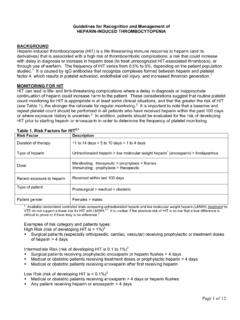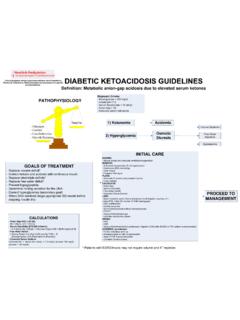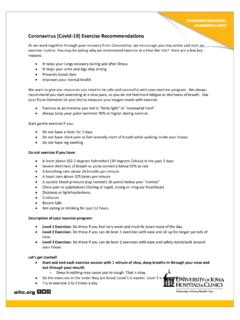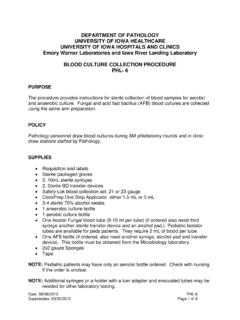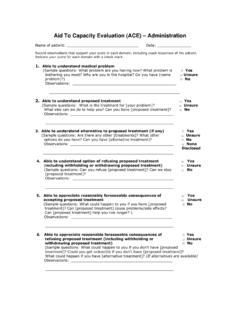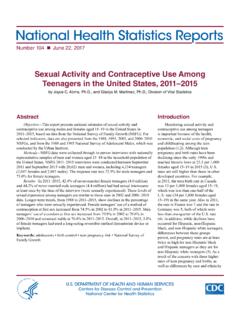Transcription of Appendix Algorithm for Abnormal Uterine Bleeding
1 Appendix Algorithm for Abnormal Uterine Bleeding Table of Contents Figures Boxes Figure 1. Abnormal Uterine Bleeding Between Box 1. Bleeding Patterns. Definitions and Criteria. Menarche and Menopause Box 2. Combination Oral Contraceptive pill Figure 2. First Trimester Bleeding Box 3. Progesterone Therapy Figure 3. Severe Acute Bleeding in the Nonpregnant Patient Box 4. Uterine Bleeding : Variations of Normal and Minor Abnormalities Figure 4. Irregular Bleeding in the Nonpregnant Patient Box 5. Evaluation for Systemic Cause of Abnormal Uterine Bleeding Figure 5. Menorrhagia in the Nonpregnant Patient Box 6. Contraindications Figure 6. Secondary Amenorrhea Box 7. Treatment of Polycystic Ovary Syndrome Figure 7. Oral Contraceptive pill Associated (PCOS). Bleeding Box 8. Endometrial biopsy vs.
2 Transvaginal Figure 8. Depo-Medroxyprogesterone or Ultrasound (TVUS). Progesterone-Only pill Associated Bleeding Box 9. Abbreviations Figure 9. Intrauterine Device Associated Bleeding Box 10. References Figure 10. Endometrial Biopsy (Pipelle Aspiration). Figure 11. Possible Polycystic Ovary Syndrome (PCOS). Figure 1. Abnormal Uterine Bleeding Between Menarche and Menopause Obvious non- Do history and physical exam. Uterine source Patient-specific management Pregnant Rule out pregnancy. Figure 2. Use Box 1 to determine Bleeding pattern. Severe acute Irregular Secondary Any Abnormal pattern associated with certain Menorrhagia Bleeding Bleeding amenorrhea contraceptive methods: Oral contraceptive pill (OCP) Figure 7. Depo-medroxyprogesterone (DMPA) Figure 8. Intra- Uterine device (IUD) Figure 9.
3 Figure 3 Figure 4 Figure 5 Figure 6. Figure 2. First Trimester Bleeding Yes IV fluids, type and crossmatch 2. Hypotensive, hypovolemic? to 4 units of packed red cells No Pelvic exam Consistent with inevitable abortion (open Not consistent with Consistent with incomplete abortion (passage cervix, no passage of POC). Ultrasound, incomplete or of POC). Suction curretage vs. misoprostol quantitative serum HCG. Expectant inevitable abortion ( , Zhang et al), if doubt completed abortion. management vs. suction curretage vs. Or ultrasound to document completed abortion. misoprostol ( , Zhang et al) depending on Decisions based on amount of Bleeding , signs amount of Bleeding , signs of infection and of infection and patient preference. Rhogam if patient preference. Rhogam if RH negative; RH negative; MICR hogam if<12 wks).
4 MICR hogam if<12 wks). Ultrasound Intrauterine pregnancy? Molar pregnancy? Ectopic pregnancy? No cardiac activity. HCG does not Bleeding resolves and serum Refer for suction Refer for surgery increase by at least 66% in 48 hours HCG increases by at least curettage and further or methotrexate (missed abortion). Suction curretage 66% in 48 hours? management. vs. expectant management vs. oral or vaginal misoprostol ( , Zhang et al). Rhogam if RH negative MICR hogam if<12 wks). Follow closely as outpatient Figure 3. Severe Acute Bleeding in the Nonpregnant Patient Three main causes: * adolescent with coagulopathy (usually vonWillebrands disease). * adult with submucous fibroids * adult taking anticoagulants Hospital admission indicated? (orthostatic hypotension, hemoglobin <. 10 gm/dL, profuse active Bleeding , social factors).
5 No Yes 1. Premarin 25 mg IV q4h x 24h + Phenergan 25 mg PO or IM. 1. Premarin mg PO qid plus Phenergan 25 mg PO or IM or or PR. PR. 2. D&C if no response after 2 doses of Premarin. 2. D&C if no response after 1-2 doses. 3. Transfuse 2 units packed RBC if hemoglobin < gm/dL. 3. After acute Bleeding stopped, switch to OCP (Box 2) (eg, LoOval 1 active pill qid x 4d, TID x 3d, BID x 2 days, qd x 3 4. Simultaneous with IV Premarin, start OCP (Box 2) ( , weeks, then off 1 wk, then cycle on OCP for at least 3 months). LoOval 1 active pill qid x 4d, TID x 3d, BID x 2 days, qd x 3. weeks, then off 1 wk cycle on OCP for at least 3 months). 4. If OCP contraindicated, cycle Provera (Box 3) for at least 3. months. 5. If OCP contraindicated, cycle Provera (Box 3) for at least 3. months. 5. Oral iron depending on hematocrit.
6 6. Oral iron. TVUS, TSH, CBC, platelet count, prothrombin time, activated partial thrombplastin time (aPTT), platelet function analysis Further diagnostic evaluation or referral to hematologist depending on clinical findings Figure 4. Irregular Bleeding in the Nonpregnant Patient Abnormal Obtain TSH. If oligomenorrhea or hypomenorrhea, obtain Prolactin Further evaluation Normal Normal variant for which observation is indicated (See Box 4)? Yes Menstrual calendar, return in 3 months No Over age 35 OR high risk for endometrial carcinoma? Yes Endometrial biopsy, consider TVUS (Figure 10). No Yes Clinical features consistent with PCOS ( , obesity, hirsutism)? PCOS evaluation (Figure 11). No Consider systemic cause (See Box 5). Yes Patient wants to achieve pregnancy? Treat for infertility ( , Speroff L, et al.)
7 No Contraindication to OCP (See Box 6a)? Yes No OCP ( , Necon 1/35) for at Progesterone ( , medroxyprogesterone {Provera} 10 mg daily for 14. least 3 months (See Box 2) days, off 14 days, then repeat) for at least 3 months (See Box 3). No Continue or stop hormonal therapy Abnormal Bleeding persists or intolerant to hormonal therapy? according to patient wishes. Yes Consider higher dose OCP ( , Demulen 1/50) for several months or contraceptive patch or vaginal ring or higher dose progesterone. Obtain coagulation studies if there are other signs of coagulopathy. Consider TVUS to rule out Uterine myoma or polyp. Consider endometrial biopsy to rule out atypia or carcinoma (Figure 10). If medical therapy fails, consider endometrial ablation, hysteroscopic resection, or hysterectomy. Figure 5.
8 Menorrhagia in the Nonpregnant Patient Obtain: (1) TSH; (2) Hemoglobin if anemia likely; (3) Platelet function analysis in most patients ( , PFA-100 ), especially for severe menorrhagia, or other signs of coagulopathy, or heavy Bleeding at menarche, or planned surgical intervention including endometrial biopsy. 4. TVUS if anatomic cause suspected ( , enlarged uterus on pelvic exam). Contraindication to OCP (See Box 6a)? No Yes Cycle on OCP ( , Necon 1/35) starting Sunday Progesterone ( , medroxyprogesterone {Provera} 10 mg daily starting after LMP for at least 3 months (See Box 2). day 14 of cycle, take for 14 days, off 14 days, then repeat) for at least 3. Other options include NSAIDS or no treatment. months (See Box 3). Other options include NSAIDS or no treatment. Consider hysteroscopic resection, Uterine Polyps or submucous Response inadequate artery embolization, endometrial myomas?
9 Ablation, hysterectomy, or observation TVUS Endometrial hyperplasia Endometrial sample (>10mm double thickness) (Figure 10). Normal or abnormalities not amenable Adenomyosis Consider progesterone therapy or to conservative procedure levonorgestrel IUD (See Box 3). Childbearing complete? No Menstrual calendar. Monitor hemoglobin. Yes Consider endometrial ablation or hysterectomy Figure 6. Secondary Amenorrhea Positive Urine pregnancy test Further care as indicated Negative Prolactin TSH. high Abnormal Obtain free T4 and proceed with Further evaluation as TSH, Prolactin further evaluation and treatment ( , indicated ( , Schlechte JA). Speroff L, et al). Both normal Lack of withdrawal Bleeding indicates an Provera 10 mg qd x 5-7 days. end-organ problem ( , Asherman's No syndrome) or lack of endogenous estrogen.
10 Withdrawal Bleeding occurs? (consistent with anovulation) Further evaluation is beyond the scope of this Algorithm (see Speroff L, et al). Yes Refer or consult other Yes Wants to achieve pregnancy sources ( , Speroff L, et al). No Consider increased calorie intake, OCP to Hypothalamic amenorrhea ( , exercise, Yes replace estrogen, bone density weight loss) with low estrogen state? measurement, calcium 1000 mg daily, No Vitamin D 400 IU daily ( , Warren MP). Provera 10 mg qd x 5-7 days every 3 months or other progesterone regimen (See Box 3) or OCP if not contraindicated (See Box 6a). Consider PCOS evaluation depending on physical findings (Figure 11). Figure 7. Oral Contraceptive pill Associated Bleeding Menorrhagia (regular but heavy periods) Breakthrough Bleeding Amenorrhea Menorrhagia Algorithm (Figure 5) Rule out pregnancy First 3 months of OCP use?

